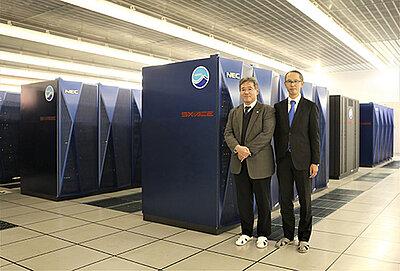Flood prediction in Japan
NEC SX-Aurora TSUBASA helps in predicting river floods 6 hours ahead
Floods are among the worst of natural disasters. From any metric – financial loss to the human toll, floods rank alongside earthquakes, tsunamis, and hurricanes. Being an island country, Japan experiences heavy rains, resulting in subsequent damage throughout the year. To combat the situation and facilitate quick evacuation, Mitsui Consultants Co. Ltd, Disaster Prevention Research Institute-Kyoto University and NEC Corporation have developed ' A National Version of the Real-time Inundation Prediction System' by using Rainfall-Runoff Inundation (RRI) model. The system allows immediate analysis and prediction of simple river channel flow into flood inundation 6 hours ahead in time by recording rainfall data. This system is built on a centralized ecosystem and embraces all rivers (major and minor) in Japan.
Damage due to torrential rains and typhoon in Japan
The incessant rains of 2018 brought severe damage to many parts of Japan, worst hit was western Japan, but that torrential rains have hit even Hokkaido and Chubu. Even prior to this, the relentless torrential rains were a reason of worry for residents and government alike. Heavy rains in northern Kyushu in July 2017, flooding in several areas of Hokkaido and Tohoku in August 2016, and heavy rains in Kanto and Tohoku in September 2015 caused severe damage to the area. This made the team at Mitsui Consultants Co. Limited, realize the country’s need for an efficient flood monitoring system. A system that could predict flooding situations well ahead in time and control the damage spread efficiently.
However, building only a flood prediction system was not the solution. For the national rivers which were managed by the government, flood prediction systems were already in place. But they were not ‘flood inundation systems’ that could look at the after-effects of flooding. On the contrary, the situation with small and medium-sized rivers was even worse as the municipalities which managed them could not afford to install and maintain a water level management and forecasting system. Embracing small rivers was pertinent to the system. The typhoon Hagibis in 2019 was a great example here as it led to the unexpected flooding of the tributaries.
Achieving a holistic flood prediction system covering all rivers of the country
 Atsuhiko Konja, General Manager River and Sabo Division, Mitsui Consultants Co. Ltd
Atsuhiko Konja, General Manager River and Sabo Division, Mitsui Consultants Co. LtdMr. Atsuhiko Konja, General Manager River and Sabo Division, Mitsui Consultants Co. Ltd, was determined to solve this impending issue and this led to his collaboration with Kyoto University. He said “We wanted to build a national version of real-time inundation forecasting system. A system that could detect serious conditions, even in small and medium-sized rivers, where information is scarce.”
This led to the birth of “Nationalized Real-Time Inundation and Forecasting System”. It was built on the concepts of the “Rainfall-Runoff Inundation (RRI)” model. The system divides the entire country into 4-second mesh resolutions (approximately 120m x 100m) based on topographic data and performs calculations such as high-resolution Precipitation Nowcast which is distributed by the Japan Meteorological Agency and numerical national land information provided by the Geospatial Information Authority of Japan. This system can not only predict water levels but also analyze if there is a chance of flooding for all rivers throughout Japan. The information is easily accessible to residents and stakeholders through a web browser.
Mr. Konja added, "I was able to move from flood forecasts to flood inundations because I knew of the emergence of RRI model that performs runoff analysis and flood analysis at a high speed for a series of flows including rainfall to runoff and flooding.”
 Takahiro Sayama,Associate Professor of Disaster Prevention Research Institute, Kyoto University
Takahiro Sayama,Associate Professor of Disaster Prevention Research Institute, Kyoto UniversityThis RRI model was developed by Mr. Takahiro Sayama, Associate Professor of Disaster Prevention Research Institute, Kyoto University. He said "When heavy rainfall disasters occur simultaneously across multiple locations, such as Typhoon Hagibis in 2019 and the torrential rains in western Japan in 2018, it is desirable to analyze a wide area, including small and medium-sized rivers where there is no observation information in an integrated manner,"
The development of the RRI model covering the entire country was accelerated when Associate Professor, Dai Yamazaki, from the Institute of Industrial Science, University of Tokyo, developed a technology to build a high-precision and high-resolution model of the waterfall direction and opened up the data in the form of a "Japan Flow Direction Map". "However, when working on the national version of the flood forecast, it was essential to have a superior performance computing environment in place that could enable high-speed calculations", said Mr. Konja
NEC Vector Processors to Analyze Multiple Simultaneous Heavy Rainfall Events
 Earth Simulator, Japan Agency For Marine-Earth Science And Technology (JAMSTEC)
Earth Simulator, Japan Agency For Marine-Earth Science And Technology (JAMSTEC)Mitsui Consultants Co., Ltd knew they need to pursue high-speed processing to realize real-time services. They knew that during floods, this computer load would be much higher as increased channel flow, and expanded inundation of the flood plains would make calculations longer and complex. They started building the processing system through a standard LINUX server. But they found that it just not possible to finish the operation on the same day with it, no matter how much time they spent on it. Getting results in real-time was a dream.
Therefore, in June 2018, they asked the Japan Agency for Marine-Earth Science and Technology (JAMSTEC) for help. JAMSTEC owns the Earth Simulator, one of the World's largest large-scale vector supercomputers. JAMSTEC promotes research and development of Japan's marine and earth sciences, encourages a comprehensive understanding of global climate change, disseminates scientific knowledge, contributes to activities of industries, and promotes innovation.
The "Earth Simulator" has been operated by JAMSTEC since March 2002, but the "Earth Simulator" discussed here is a third-generation system that started its operation in March 2015. NEC vector-type supercomputer was used in the third generation of the Earth Simulator.
To utilize a supercomputer, the performance of a compiler that automatically converts a program is very essential. Besides, it was necessary to tune (optimize) the program on its own to maximize the capabilities of the Earth Simulator. Mr. Konja said “This is why we chose NEC's vector supercomputer. It is good at parallel computing and can compute and process a variety of data at the same time. Additionally, it has globally strong use cases in the field of weather forecasting.”
 Hitoshi Uehara, Ph.D., Group Leader, Supercomputer Engineering and Administration Group, Center for Earth Information Science and Technology (CEIST), Research Institute for Value-Added-Information Generation (VAiG), Japan Agency for Marine-Earth Science and Technology (JAMSTEC) |
 Yoshiyuki Imato, Engineer, Supercomputer Engineering and Administration Group, Center for Earth Information Science and Technology (CEIST), Research Institute for Value-Added-Information Generation (VAiG), Japan Agency for Marine-Earth Science and Technology (JAMSTEC) |
Dr. Hitoshi Uehara and Mr. Yoshiyuki Imato from JAMSTEC supported tuning to speed up the river inundation prediction. "For local people to be able to evacuate safely and convincingly, the system is required to forecast for about five hours to come and to have a certain level of accuracy in it. It is necessary not only to show the river level in real-time but also predict flooding after the overflow with a high degree of accuracy. Therefore, we wanted the system to complete the calculation within 30 minutes from the time the data is entered.” It was a hurdle set by Mitsui Consultants. “This was definitely a difficult hurdle, but I wanted to work on it and contribute to the society with the best of my knowledge”, said Dr. Uehara.
The JAMSTEC team continued to work and six months later, at the beginning of 2019, they were able to shorten the calculation time to 19 minutes. This was well ahead of the target, against the required 30 minutes’ hurdle.
This resulted in river inundation prediction one hour ahead of time. It was a moment that opened the door to the practical application of the national version of a real-time flood forecasting system.
The members JAMSTEC, who succeeded in speeding-up the calculation, had high expectations for the future of vector supercomputers. Dr. Uehara said, "There is no doubt that at one time, the scalar type supercomputers had created a buzz and vector type computers were not popular enough. But globally, I feel that vector technology should be incorporated into every supercomputer, and vector technology is rebounding.”
He added, “NEC's supercomputer has a "compiler" equipped with an automatic vectorization function that has accumulated knowledge and know-how for many years. This technology is globally valuable. I hope it will never be lost and will be passed on to the next generation."
Mr. Imato said "NEC Vector supercomputers show overwhelmingly strong performance when conditions are matched and have an appeal that no other computer can compete with. Many researchers like this feature, so I hope NEC will continue to develop vector supercomputers."
 Kogaku Nagaya, Manager of System Platform Business Unit, AI Platform Division, NEC
Kogaku Nagaya, Manager of System Platform Business Unit, AI Platform Division, NECThe national version of the real-time inundation forecasting system aims to become more sophisticated and enable advanced forecasts.
Kogaku Nagaya, Manager of System Platform Business Unit, AI Platform Division-NEC, helped tune the program created in JAMSTEC and implemented it through the latest vector-type supercomputer "NEC SX-Aurora TSUBASA". This system is expected to make predictions every 30 minutes for six hours ahead. In the event of a typhoon or heavy rain, NEC's vector supercomputers would play a major role in ensuring the complete safety and security of residents.
NEC SX-Aurora TSUBASA is a general-purpose server equipped with an "x86 processor". Its capability lies in the fact that it delivers sustained high performance and ease of use and could work in an environment where "OS Linux" can be used.
 Rie Tou, Sales Marketing Director of System Platform Business Unit, AI Platform Division, NEC
Rie Tou, Sales Marketing Director of System Platform Business Unit, AI Platform Division, NECRie Tou, Sales Marketing Director of System Platform Business Unit, AI Platform Division, NEC explains, "NEC supercomputer comes with a structure that excels in parallel processing of all data at once, and is particularly effective in areas such as meteorology and fluid analysis.”
Nagaya is enthusiastic and added, "I would like to continue to support the realization of real-time operation so that we can achieve higher speeds and more improved real-time performance."
NEC has already received an order from Deutscher Wetterdienst (DWD), one of Europe's three major meteorological stations, for a weather forecasting system that uses SX-Aurora TSUBASA. According to Tou, "The system is highly valued not only for high performance but also for its power-saving capabilities."